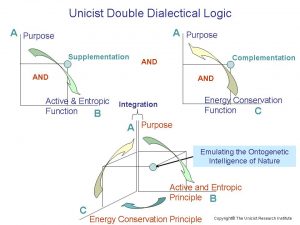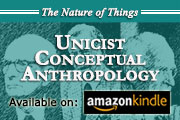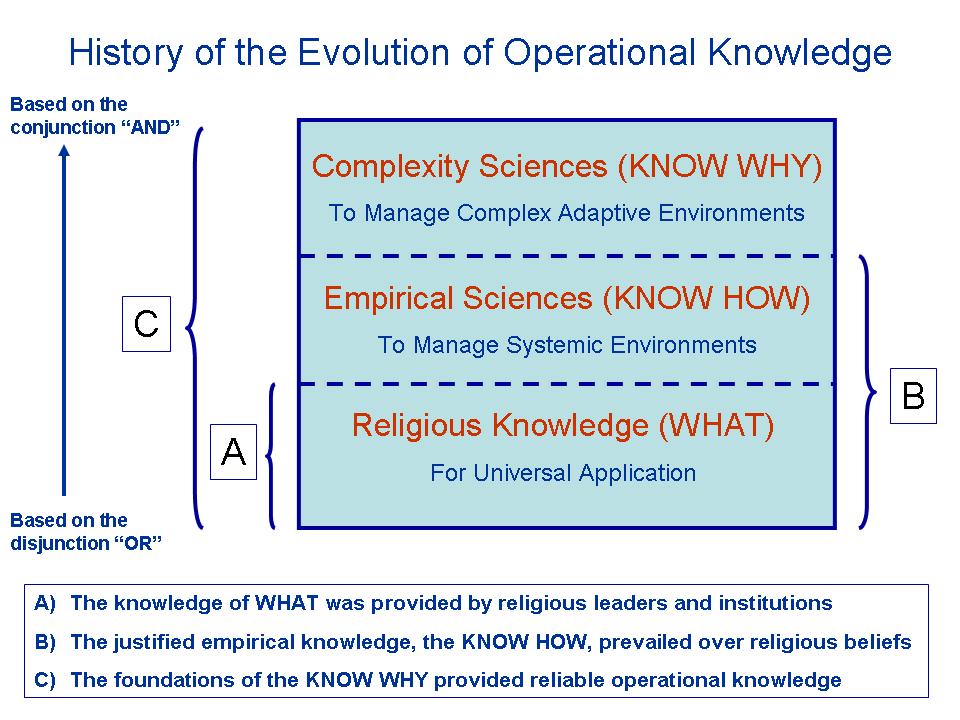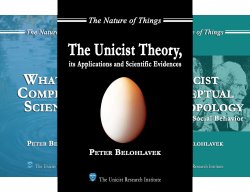The paradigm shift of the Unicist Theory is based on the discovery of the ontogenetic intelligence of nature, which is the intelligence that underlies nature. It establishes the basic structures of behavior in nature, including the evolution of human behavior. The understanding of the unicist paradigm shift is necessary to accept the validity of the resulting applied technologies.
 Giving Birth to Complexity Sciences
Giving Birth to Complexity Sciences
The final goal of the Scientific Research developed by Peter Belohlavek at The Unicist Research Institute was to find a structural solution for complexity as a universal problem.
The Unicist Theory gave birth to Complexity Sciences, providing both their epistemological structure and their integration with Systemic Sciences. This allowed developing a scientific approach to adaptive environments.
At an operational level the objective was to deal with complex adaptive systems. These systems might be natural systems or artificial complex adaptive systems like cultures, institutions or information systems.
The Paradigm Shift: The Path towards Double Dialectical Actions
The objective of the research works developed at The Unicist Research Institute has been the development of solutions to influence complex environments in order to foster their evolution. This research drove to a paradigm shift in science, which is based on emulating the maximal and minimum strategies that are implicit in the intelligence that underlies nature.
This allowed discovering the double dialectical behavior of nature and transferring this knowledge to its application to deal with adaptive environments in order to ensure the results that are being fostered.
The core application of the paradigm shift in sciences was the development of maximal strategies to grow and minimum strategies to ensure survival using double dialectical actions to manage functions in complex environments in order to ensure results.
Dealing with Living Beings and Complex Adaptive Entities
The unicist approach to complexity emulates nature to deal with natural or artificial complex adaptive systems. Such emulation is based on the discovery of the ontogenetic intelligence of nature that regulates the evolution of living beings and natural entities.
The Unicist Theory explains the dynamics and evolution of living beings and complex adaptive entities. It substituted empiricism by a pragmatic, structuralist and functionalist approach and replaced knowledge falsification processes with destructive testing processes.
The four pillars of the paradigm shift developed by Peter Belohlavek are:
- The unicist theory, which explains the dynamics and evolution of living beings and complex adaptive entities.
- The unicist theory of evolution, which allows forecasting the future.
- The epistemological structure of complexity sciences, which allows managing the complex aspects of reality.
- The unicist theory of the unified field in nature, which allows managing the unified field of complex adaptive systems.
The Unicist Theory
The Unicist Theory explains the evolution and dynamics of complex adaptive entities whether they are natural beings or artificial entities. This theory is based on the discovery of the triadic structure of the ontogenetic intelligence of nature.
 The purpose of this theory is to provide a framework to forecast the evolution of adaptive entities considering their restricted and wide contexts.
The purpose of this theory is to provide a framework to forecast the evolution of adaptive entities considering their restricted and wide contexts.
This theory describes the universal structure of the unified field in nature that is applicable to all complex adaptive entities whatever their kind. It needs to be considered that the unified field has a triadic structure that is homologous to the structure of the ontogenetic intelligence of nature.
The evolution of complex adaptive entities is based on the laws of the ontogenetic intelligence of nature. This intelligence includes an active principle that drives the evolution and establishes the maximal strategy of the entity while it generates entropic effects. It also includes an energy conservation principle that establishes a minimum strategy to ensure the survival.
This theory allows emulating the organization of nature when dealing with adaptive environments. It is based on forecasting their future scenarios, defining the functional unified fields based on the knowledge of the ontogenetic map that defines their conceptual structure. This approach simplifies the management of complex environments.
Expanding the Boundaries of Sciences
As it is known, the management of complexity has been an unsolved challenge for sciences. This challenge was faced in 1976 by The Unicist Research Institute that was a pioneering organization in finding a structural solution for complexity without using artificial palliatives.
The paradigm shift, based on the emulation of nature, was developed to solve the need of having reliable knowledge to deal with complex environments. It was provoked by the fallacy of considering empirically-justified knowledge as reliable knowledge.
It allowed managing complex environments as a unified field.
The paradigm shift was triggered by the need to understand complex adaptive systems. The shift implies having subordinated the empirical approach to sciences to a pragmatic, structuralist and functionalist approach to deal with complex environments that integrates, at an operational level, the preexisting empiricism.
This is a superior level in sciences that integrates complexity sciences with systemic sciences using the double-dialectical logic to emulate the ontogenetic intelligence of nature and using objects to emulate the organization of nature.
The scientific evidences of the Unicist Theory
In this document you will find seven scientific evidences of the Unicist Theory, which confirm its functionality, that allows dealing with complex systems. These evidences are:
- The functionality of amino acids
- The structure of atoms
- The structure of biological entities
- The nervous system
- Similarity between natural and social objects
- The homology between the unicist concepts and the stem cells
- The homology between thinking processes and the functionality of electricity
Access the scientific evidences: http://unicist.info/sdc-en/scientific-evidences
A Synopsis of the Paradigm Shift in Science
(Before and After the Unicist Theory)
This synopsis describes the “before” and “after” the development of the unicist approach to complexity.
The Unicist Theory changed Sciences as they are known
Before: Sciences were based on an empirical cause-effect approach that was functional in systemic environments but dysfunctional to deal with complex adaptive environments that have open boundaries and bi-univocal relationships among their components.
After: The unicist approach to sciences is based on a pragmatic, structuralist and functionalist framework that allows integrating the scientific approach to both complex and systemic environments. It subordinates the empirical approach to deal with operational aspects after the complex aspects have been managed using a unicist ontological approach. It integrates systemic sciences and complexity sciences in a unified field.
Example in Economics: The knowledge of the unicist ontogenetic maps allow defining the structural economic solution for an entity and the use of the technical-analytical tools allows defining and monitoring the operation.
Development of the Epistemological Structure of Complexity Sciences
Before: The category of complexity sciences was inexistent as such. The understanding of complexity was simplified by using artificial palliatives, to generate pseudo-systemic structures of variables. This implies using a dualistic empirical approach to reality.
After: All fields of reality where their evolution depends on the feedback from the context belong to the field of complexity sciences. Complexity Sciences provide solutions for adaptive environments.
Natural or artificial complex adaptive environments are approached as unified fields that are defined and regulated by their ontogenetic structures and are constituted by processes and objects that work as complex adaptive entities. This approach implies using a triadic, pragmatic, structuralist and functionalist framework.
Example: This is the case of natural sciences, life sciences, social sciences, economic sciences, political sciences, anthropology, behavioral sciences, etc.
Discovery of the Ontogenetic Intelligence of Nature
Before: The structure that regulates the evolution of nature was unknown.
After: The structure of nature that regulates its evolution is given by the triadic structure of the ontogenetic intelligence of nature.
This intelligence is defined by a purpose, an active principle and an energy conservation principle that are integrated in their oneness defining the functionality of the entity. The active principle drives the evolution while the energy conservation principle sustains the purpose. The ontogenetic intelligence of an entity defines its intrinsic concepts that regulates its evolution.
Example: 1) The structure of the human nervous system where the purpose is defined by the vital function, the active function is given by the motor system and the energy conservation is given by the sensitive system. 2) The structure of the atom where the purpose is given by the protons, the active function is given by the electrons and the energy conservation function is given by the neutrons.
Discovery that the Evolution of Living Beings is driven by a Purpose
Before: The evolution is random.
After: Evolution is purpose driven to sustain the survival of the species.
Example: The evolution of finches explained by Charles Darwin. The beak of the finches evolves to ensure the survival of the species.
Discovery of the Structure of the Unified Field in Nature
Before: The apprehension of the Unified Field has been an unsolved problem in sciences. The apprehension of nature was considered as part of intuition and an evidence of wisdom.
After: The Unicist Theory gives access to the triadic structure of the unified field in nature that defines the concept that regulates its evolution.
The discovery of the triadic functionality of ontointelligence allowed apprehending the unified field in nature. It solved the problem of the integration of solutions that are incompatible at an operational level.
This intelligence, that is used by individuals to apprehend the nature of a reality, is integrated by the ethical intelligence, the strategic intelligence and the logical thought. It requires being able to deal with the ambiguity implicit in any complex environment.
It opened the possibility to make reasonable, understandable and provable the emulation of nature. It defines the possibility of managing different levels of complexity in the real world.
Example: The ethical intelligence is the deepest intelligence of human beings that evolves with their maturity and defines the true intentions of individuals when dealing with the environment. It is functional when it is consistent with the ethical intelligence of the environment.
Discovery of the Basic Law of Evolution
Before: The structure of nature was unknown therefore there were no laws of evolution
After: The evolution implies that the active principle drives the evolution of an entity while the energy conservation sustains the status quo.
When the energy conservation principle prevails, the entity becomes stagnated in order to survive.
Example: 1) The change of the beak of finches is an example of evolution. 2) The encystment of microorganisms is an example of the prevalence of the energy conservation principle.
Application of the Unicist Ontology of Evolution to future research
Before: The evolution of living beings or complex adaptive environments was forecasted based on experiential benchmarks, the consensus of expert opinions or the use of intuition (Nostradamus and others).
After: The unicist approach to evolution is based on discovering the unicist ontological structure of an environment and using the signs and symptoms in order to infer the future using the principles of evolution. The opinions of experts are used as destructive tests, while pilot forecasts are used as non-destructive tests.
Example: The development of county future scenarios or business long-term planning.
Discovery of the Organization by Objects of Nature
Before: The Complex Adaptive Systems were managed as systemic systems to manage their processes and functions.
After: Complex adaptive systems, being natural entities or artificially created, are integrated by objects, which are integrated in a unified field.
Each object is an interdependent autonomous entity that fulfills a function and has a quality assurance that ensures its functionality.
Example: 1) The human body is integrated by objects that are evident to everyone and other objects that are not. The organs of the body are objects that are evident and the amino-acids belong to the category of not evident objects. 2) Countries are social entities organized by objects that function as institutional roles. 3) Institutionalized businesses are complex adaptive entities that are organized by objects and functional roles to ensure their permanence.
Development of the Research Framework for Complexity
Before: The Empiric frameworks were used in order to falsify hypotheses.
After: The use of a Pragmatic, Structuralist and Functionalist framework was the basis for the development of destructive tests to define the limits of knowledge and non destructive tests to confirm the functionality.
Example: 1) The research of complexity has to be done in a real environment and not in artificial environments. 2) The research of complex environments requires an ontological research focused on the objects that integrate a complex adaptive system.
Development of the Unicist Epistemology to Build Reliable Knowledge
Before: Empiric knowledge is validated by confirming its justifications.
After: Reliable knowledge of complex systems is validated using “foundations” to confirm the functionality of their concepts and justifications to confirm the operational aspects.
Example: The statistical validity of human behavior needs to be applied based on considering that each conceptual segment of a population is an independent universe.
Discovery of the Relationships between Elements in Nature
Before: There was no knowledge about the conceptual structure of the relationships in nature.
After: The relationships between the elements that integrate a unified field are complementary or supplementary.
There are no other types of relationships among the elements that integrate a unified field than those of complementation and supplementation.
Example: The purpose and the active function of a concept have a relationship of supplementation. The relationship between the purpose of the concept and the energy conservation function is based on a complementary relationship.
Discovery of the Structure of Extrinsic Concepts and Mental Concepts
Before: (1724 – 1804) Immanuel Kant defined that concepts have a functional meaning that is the framework of any action.
 After: The concepts of non-living entities have the same structure of the ontogenetic intelligence of nature, defined by a purpose, an active function and an energy conservation function that define the extrinsic concepts.
After: The concepts of non-living entities have the same structure of the ontogenetic intelligence of nature, defined by a purpose, an active function and an energy conservation function that define the extrinsic concepts.
These functions work as a unified field that drives human action. The extrinsic concepts define the functionality of things and are deposited by humans in order to manage their nature.
The structure of extrinsic concepts is timeless and cross-cultural; their credibility zone is defined by the environment and its conjuncture. They exist as long as the function exist. The mental concepts are the concepts that guide the actions of individuals and are stored in their long term memory.
Example: The concept of leadership is integrated by a purpose, which is to sustain the authority of an individual, its active function is given by the participation with the group and the energy conservation function is given by the power that an individual has to influence the context.
Development of the Unicist Ontology
Before: Ontology was an approach to apprehend the nature of reality, which belonged to the field of philosophy.
After: Unicist ontology is a structured approach to apprehend the nature of complex adaptive systems using an emulation of the ontogenetic intelligence of nature.
The unicist ontology is necessary to deal with Complexity Sciences because it allows defining the concepts that guide actions.
Example: The nature of any strategic approach to reality implies an emulation of nature meaning that there is a purpose to be achieved, the active function is given by a maximal strategy that drives beyond existing boundaries in order to provoke evolution, and the energy conservation function is given by a minimum strategy that ensures survival.
Discovery of the Structure of Complex Adaptive Systems
Before: The complex adaptive systems were considered as systemic systems. They were managed considering their functional elements as variables.
After: A complex adaptive system is considered as an open system, in which the conjunction of objects and/or subsystems determines the functionality of the unified field.
These systems have no variables but objects that are integrated by the conjunction “and”. In complex systems there is no “or” in the relationships of their objects.
Example: The human body is a paradigmatic example of a complex adaptive system that has no variables. It has objects that fulfill functions and processes that establish the relationships between these objects. The organs of the body are evident objects.
Discovery of the intelligence to deal with complexity
Before: The use of analogical thinking was dominant and critical thinking was a superior approach to adapt to the environment.
After: The ontointelligence to deal with the unified field of complex environments was discovered. This drove to the integration of analogical thinking, critical thinking and unicist thinking that allows apprehending the unified field and fundamentals of a given reality. Analogical thinking is spontaneous and based on genetic intelligence, critical thinking requires an analytical thinking process and unicist thinking demands the use of a unicist reflection process.
Example: The design of solutions of complex problems.
Development of the Double-dialectical Logic
Before: The logical approach to deal with sciences was based on empiricism, which requires the use of a dualistic approach in order to disregard the unified field of complex adaptive systems.
Dualism has two main justifications that sustain the artificial isolation of aspects of reality. On the one hand, the “Truth Tables” (True or False) are an example of dualistic logic that is functional to manage systemic functions. But they are dysfunctional to deal with the unified field of complex adaptive environments.
 On the other hand, “Ceteris Paribus” is a fallacious solution to isolate variables or aspects of reality that is based on defining all other aspects of a problem as constants. It is used to confront adaptive environments without needing to adapt.
On the other hand, “Ceteris Paribus” is a fallacious solution to isolate variables or aspects of reality that is based on defining all other aspects of a problem as constants. It is used to confront adaptive environments without needing to adapt.
After: The double-dialectical logic is an integrative logic based on the use of conjunctions to define the structure of the unified field of complex adaptive systems using double-dialectical thinking.
The elements included in complex environments are not true or false. They are defined by their levels of functionality. Their functionality is defined by the value generated by the integration of their triadic functions that require the use of the logic of double-dialectics in order to be understood.
Example: Both the dialectics of Hegel and Marx have a dualistic basis using a thesis-antithesis model that drives to a resulting synthesis.
But cultures have homeostatic elements that participate in the social process which implies a triadic dialectical approach defined by a thesis-antithesis-homeostasis model.
To access a triadic approach with a dualistic mind-set (the neurons are on or off) it is necessary to use a double-dialectical model that integrates thesis and antithesis in the active function with the thesis and homeostasis in the energy conservation function.
The double-dialectical logic is a mind-set that needs to be used to emulate the ontogenetic intelligence of nature in order to manage concepts to deal with complex adaptive systems.
Scientific applications of the Unicist Theory that expanded the boundaries of existing sciences by solving their complex aspects:
In Scientific Research – 1980: Development of a unicist ontological methodology for complex systems research, substituting the systemic approach to research adaptive systems. 2014: The integration of the unified field of macro and micro behavior. 2015: Development of the destructive and non-destructive tests to research adaptive environments.
In Life Sciences – 1988: Discovery of the functional structure that regulates evolution and the unicist ontological structure of living beings as a unified field. 2006: Discovery of the unicist ontological algorithm of evolution and involution. 2008: Discovery of the two types of integration, complementation and supplementation, of elements in complex adaptive systems.2012: Discovery of the unicist ontology of biological entities. 2013: Confirmation of the unicist ontology of viruses. 2014: Discovery of the ontological structure of chronic diseases. 2014:Discovery of the structure of therapeutics. 2015: Discovery of the ontological structure of health. 2016: Development of the Scientific Foundations of Medicine.
In Complexity Sciences – 1998: Development of the unicist ontology emulating the ontogenetic intelligence of nature. 2003: Discovery of the anti-concepts that work as antimatter. 2006: Development of objects to manage human adaptive systems emulating the structure of nature. 2011: Discovery of the unicist ontology of complex adaptive systems.2014: Discovery of the behavior of objects in complex adaptive systems. 2015: Discovery of the essential opposition but operational complementation between the active function and the energy conservation function of concepts.
In Information Sciences – 2002: Development of unicist ontogenetic based ontologies replacing the empirically structured ontologies. 2014: Development of unicist adaptive robotics. 2015: Development of prototypers. 2016: Discovery of the nature of conceptual design.
In Future Research and Strategy – 1984: Modeling of the ontological structures that allow inferring the evolution developing the ontogenetic maps of human adaptive systems. 2014: Confirmation of the functionality of ethical intelligence in future research. 2015: Discovery of the unicist ontology of personal strategies. 2016: Discovery of the nature of entrepreneurial strategies.
In Logic – 1986: Development and formalization of the integrative and the unicist logic. 2013: Functionality of Dualistic Logic in complex environments. 2013: Discovery of the structure of aprioristic fallacies.
In Anthropology – 1986: Discovery of the “invariables” of human behavior. 1997: Discovery of the double dialectical behavior. 2008: Discovery of the anthropological lifestyles. 2010: Discovery of the institutional and social viruses. 2012: Discovery of the integration of ontogeny and phylogeny. 2012: Discovery of the stagnant survivors’ role in societies. 2012: Discovery of the unicist ontological structure of aptitudes, attitudes and intentions. 2013: Development of the unicist ontology of cultural adaptiveness & over-adaptiveness. 2014: Synthesis of Conceptual Anthropology. 2014: Discovery of the Cultural, Institutional, Individual and Social Archetypes. 2015: Discovery of the functionality of rationalism and subjectivism as social and individual addictions. 2016: Discovery of the nature of innovation processes.
In Economic Science – 1989: Discovery of the unicist ontological structure of Economics.1998: Discovery of the unicist ontological algorithm of the price elasticity of demand. 2004: Discovery of the ontogenetic structure of economic models and their functionality. 2011: Discovery of the ontology of currency and inflation. 2012: Discovery of the ontology of the industrialization level. 2012: Discovery of the unicist ontology of the overcoming of scarcity. 2012: Pricing of Futures and Options. 2012: Discovery of the unicist ontology of speculative manipulation. 2014: Synthesis of Conceptual Economy. 2015: Discovery of the unicist ontology of economic freedom.
In Political Science – 1990: Development of the ontological algorithm and the ontogenesis and phylogeny of ideologies and their functionality. 2013: Development of the unicist ontology of Social, Economic and Political Democracy.
In Social Sciences – 1993: Discovery of the collective unconscious and the unicist archetypes of cultures. 2012: Discovery of the role of stagnant survivor elites in the stagnation of segments or cultures. 2016: Discovery of the nature of social networks.
In Linguistics – 2004: Discovery of the unicist ontological algorithms of natural, ambiguous and figurative languages and the unicist ontology of words. 2014: Development of semantic objects. 2015: Discovery of the ontological structure of subliminal communication.
In Mathematics – 1996: Development of the conceptual basis of interdependent, dependent and independent variables. 2014: Development of the mathematical foundations of reality indicators.
In Philosophy – 1994: Development of the unicist ontology integrating philosophy, science and action in a unified field. 1997: Refutation of Hegel’s and Marx’s dialectics and the formulation of the laws of the double dialectics.
In History – 2000: Development of a historical analysis methodology based on the unicist double dialectics.
In Cognitive Science – 2001: Development of a methodology to construct knowledge with existing information through an integrative logic. 2002: Development of the unicist reflection methodology to deal with the nature of reality. 2006: Discovery of the object driven organization of mental processes and the development of cognitive objects. 2008: Development of the ontological algorithms of fundamental analysis. 2013: Development of the unicist ontology of erudition and wisdom (observers vs. participants). 2014: Discovery of the structure of the emulation of reality. 2015: Discovery of the unicist ontology of conceptualization.
In Education – 1979: Discovery of the ontogenetic algorithms of learning which has given scientific sustainability, amongst others, to Piaget. 2014: Discovery and development of learning objects. 2015: Development of Reflection Driven Education. 2016: Discovery of the nature of learning by teaching.
In Psychology – 1984: Discovery of human ontointelligence to deal with adaptive systems. 2003: Discovery of the unicist ontological structure of fallacies, the functionality of anti-intelligence and anti-intuition. 2004: Discovery of the double dialectical thinking process. 2005: Discovery of the unicist ontology and evolution laws of human essential complexes. 2011: Discovery of the unicist ontology of conscious behavior. 2012: Discovery of the unicist ontology of complementation of thinking processes. 2012: Discovery of the unicist ontology of psychopathy. 2014: Discovery of the structure of subliminal decision-making. 2014: Synthesis of Conceptual Psychology. 2015: Functionality of concepts as behavioral objects. 2016: Discovery of the nature of human metamorphosis. 2016: Discovery of the functionality of thinking processes.
In Semiology – 2012: Discovery of the unicist ontology of semiosis as a complex adaptive system. 2015: Development of semiotic role objects.
Collection “The Unicist Theory: The Nature of Things”
 |
 |
 |
 |





